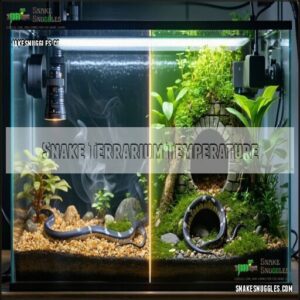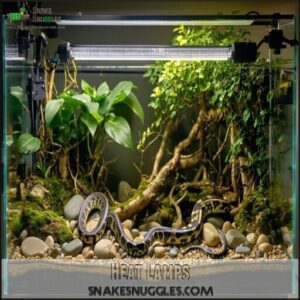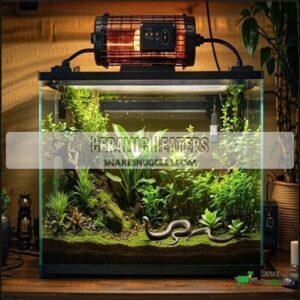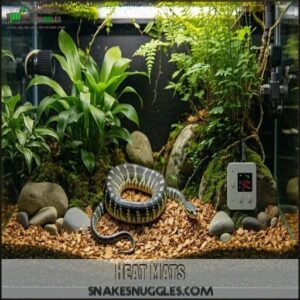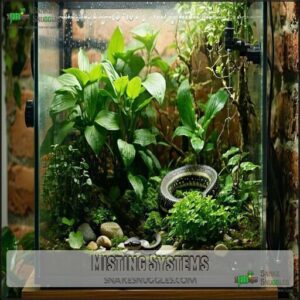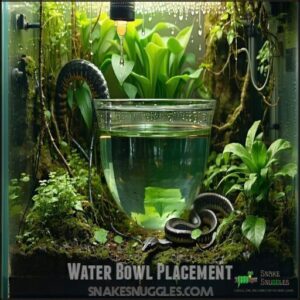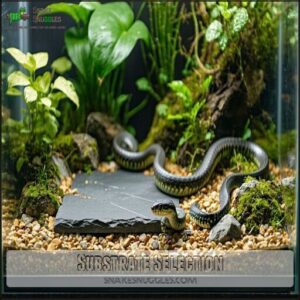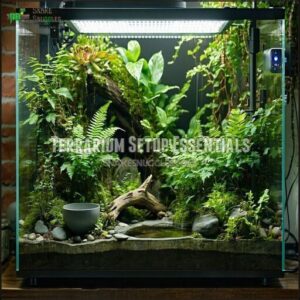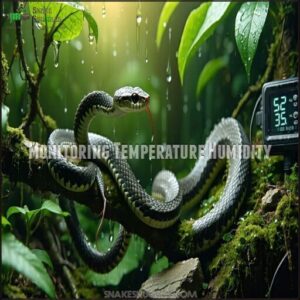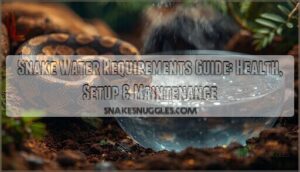This site is supported by our readers. We may earn a commission, at no cost to you, if you purchase through links.
 You’re setting up a snake terrarium and want to get it just right.
You’re setting up a snake terrarium and want to get it just right.
For an ideal temperature and humidity for snake terrarium, aim for a warm side around 80-85°F, a cool side near 75°F, and a basking spot of 95-104°F.
This temperature gradient lets your snake self-regulate.
Humidity levels vary by species, but a range of 30-50% is common.
You’ll need a reliable thermostat and hygrometer to keep things stable.
Now that you’ve got the basics, let’s get into the nitty-gritty of creating a perfect environment for your slithery friend.
Table Of Contents
- Key Takeaways
- Snake Terrarium Temperature
- Ideal Humidity Levels
- Snake Species Temperature Needs
- Creating Temperature Gradients
- Humidity Control Techniques
- Terrarium Setup Essentials
- Monitoring Temperature Humidity
- Frequently Asked Questions (FAQs)
- What is the ideal temperature range for a ball python’s habitat?
- How should I create a temperature gradient in my ball python’s enclosure?
- How important is maintaining proper humidity for ball pythons?
- Should I use UVB lighting in my ball python’s enclosure?
- How can I ensure safe temperatures for my ball python’s enclosure?
- What temp and humidity should a snake tank be?
- Is 70% humidity too high for ball python?
- Can you leave a heat lamp on 24/7 for ball python?
- Is 70 humidity too high for a corn snake?
- How often replace UVB lighting for snakes?
- Conclusion
Key Takeaways
- You’ll want to create a temperature gradient in your snake’s terrarium, with a warm side around 80-85°F and a cool side near 75°F, to keep your snake happy and healthy.
- A basking spot with temperatures between 95-104°F is essential, and you can achieve this using heat lamps, ceramic heaters, or heat mats.
- You’ll need to monitor and control humidity levels, which vary by species, but a range of 30-50% is common, and you can use a hygrometer to measure the humidity and make adjustments as needed.
- To maintain a healthy environment, you’ll need to regularly check temperature and humidity levels, at least twice a day, and make adjustments to ensure your snake’s terrarium stays within a safe range.
Snake Terrarium Temperature
You’re setting up a snake terrarium and want to get the temperature just right.
You’ll need to create a temperature gradient, with a warm side around 85-90°F and a cool side around 75-80°F, to keep your snake happy and healthy.
Temperature Gradients
You’ll create a temperature gradient, a warm and cool zone, for your snake’s terrarium, allowing them to regulate their body temperature.
This setup provides benefits including reduced stress and improved digestion, by setting up a gradient control system.
The goal is to maintain the ideal snake temperature gradient.
Basking Spot Temperatures
You’ll want a basking spot with temperatures between 95-104°F.
Consider these factors:
- Basking spot surface
- Basking spot location
- Measuring basking spot
- Safe basking spot setup
- Basking spot variations, using heat lamps or heat mats to achieve the perfect temperature gradient.
Heat Sources
You’ll use heat sources like heat lamps, ceramic heaters, or heat mats to maintain your snake’s ideal temperature.
External heat sources are necessary for proper metabolism and temperature regulation, so consider a proper snake tank setup.
These heating methods provide the warmth your snake needs, with heat lamps and ceramic heaters being popular choices for creating a cozy environment, and heat mats offering a gentle, consistent heat.
Thermostat Regulation
A reliable thermostat is your secret weapon for perfect temperature control. Think of it as the brain of your setup, keeping things cozy for your slithery friend.
- Pick a good spot for your thermostat.
- Use temperature probes for accurate readings.
- Explore different thermostat types—digital thermostats offer precise control!
- Regular sensor calibration keeps everything running smoothly.
Don’t forget, proper thermostat placement and regular thermostat calibration are key for humidity control, too!
Ideal Humidity Levels
You’ll want to get the humidity just right for your snake, as it affects shedding and respiratory health.
By monitoring humidity levels with a hygrometer and making adjustments, you can create a comfortable environment for your pet snake to thrive.
Humidity Ranges
You’ll find ideal humidity levels vary by species, with some snakes thriving in 50-60% humidity, while others need 70-80%.
Accurate monitoring is essential for reptile health, as discussed in this informative reptile guide.
Measuring humidity is key to making adjustments and preventing health issues, as incorrect levels can harm your pet, so it’s important to research the ideal humidity range for your snake, and understand the importance of accurate monitoring.
Hygrometer Monitoring
Knowing the right humidity range is half the battle.
Now, let’s talk about checking it! A hygrometer is your humidity sidekick.
Digital hygrometers are easy to read. Placement matters! Don’t stick it right next to the water dish.
Check your hygrometer combo’s accuracy. Frequency? Once a day. Calibration keeps it honest.
This helps with humidity control for snakes and guarantees proper terrarium humidity levels. A humidity gauge is key for happy snakes.
Humidity Control Methods
You’ll master humidity control for snakes by adjusting misting systems, water bowls, and substrate choice.
For automated humidity regulation, consider a snake terrarium humidifier.
Add humid hides and maintain proper ventilation to maintain ideal terrarium humidity control, making your snake’s home a happy, healthy space with the right humidity control methods and misting systems in place always.
Snake Species Temperature Needs
You’re about to learn how different snake species have unique temperature needs, and it’s essential to get it right for your pet’s health.
By understanding the specific temperature requirements of your snake, you can create a comfortable and healthy environment that meets their needs, which is crucial for their overall health.
Ball Python Temperature
You’ll want to keep your ball pythons in an ideal range of 75-90°F.
- 75-85°F for ambient temperature
- 90°F for basking spot temperatures
- 75-80°F for nighttime temps
Thermal gradient is important for achieving warmth.
Corn Snake Temperature
You manage your Corn Snake’s temperature with a thermal gradient, using heat sources and a thermostat.
| Temperature | Humidity | Lighting |
|---|---|---|
| 75-85°F | 30-50% | Low |
| 80-90°F | 40-60% | Medium |
| 85°F | 50% | High |
Hognose Snake Temperature
You’ll want to maintain a thermal gradient for your hognose snake, with basking temps around 90-95°F and night temperatures above 60°F.
For more details, review this comprehensive hognose care guide.
A heat lamp setup is ideal, and measuring temps is essential to make sure the best snake temperature and ideal temperature range for your pet’s health.
Creating Temperature Gradients
You’re going to create a temperature gradient in your snake’s terrarium, which is essential for their health and well-being.
By using heat lamps, ceramic heaters, or heat mats, you can establish a warm and cool zone, allowing your snake to regulate its body temperature and thrive.
Heat Lamps
Heat lamps consistently provide the most natural way to create your snake’s basking spot. You’ll want to position the lamp at one end of the terrarium to establish a proper temperature gradient, helping your scaly friend regulate their body heat just like they’d in the wild.
For specific product recommendations, check out this guide on best heat lamps for ball pythons.
- Select halogen flood bulbs (50-75W) for better heat distribution and longer life
- Mount lamps 12-18 inches above the basking area for ideal thermal cycling
- Install a mesh guard to prevent accidental burns and guarantee safety
Ceramic Heaters
Ceramic heaters stand as your silent guardians of warmth, providing consistent heat without disrupting your snake’s day-night cycle.
They’re fantastic for maintaining temps 24/7, but don’t forget to pair them with a thermostat – nobody wants a toasted snake.
You’ll want to mount these powerhouses above your terrarium with a proper dome fixture and mesh guard. Pick a wattage that matches your enclosure size.
Heat Mats
You’ll find heat mats useful for maintaining ideal snake temperature.
Consider heat mat placement, wattage, and substrate compatibility. Make sure thermostat control and follow safety precautions to avoid overheating.
Undertank heat mats are a great choice for a snake terrarium, providing a warm and cozy environment for your pet.
Humidity Control Techniques
You’re now going to learn how to control humidity in your snake’s terrarium, which is essential for their health and well-being.
By using techniques like misting systems, water bowl placement, and substrate selection, you can create an ideal humid environment for your pet snake.
Misting Systems
You’ll control humidity with misting systems, adjusting frequency and nozzle types for ideal droplet size.
Setting up automated misting to maintain ideal humidity levels in your terrarium misting system, ensuring a healthy environment for your snake by balancing misting frequency and system setup.
Many retailers offer complete terrarium misting system products, providing you with options to create an optimal environment with the right misting frequency and system setup.
Water Bowl Placement
Beyond misting, your water bowl placement plays a key role in humidity. A larger water bowl size naturally increases evaporation rates. Think of it like a tiny humid!
Placement impact is huge:
- A cozy corner keeps humidity steady.
- Near a heat source speeds up evaporation rates.
- Easy accessibility keeps your snake happy and hydrated.
- Regular changes maintain high-quality water quality.
Consider your snake’s needs and adjust water bowl placement to fine-tune those humidity levels.
Substrate Selection
You’ll choose a substrate that suits your snake’s needs.
For humidity control, consider safe substrate options.
| Substrate types | Moisture retention | Burrowing substrate |
|---|---|---|
| Aspen | High | Yes |
| Reptile carpet | Low | No |
Selecting the right substrate is key to maintaining ideal humidity.
Terrarium Setup Essentials
You’re setting up your snake’s terrarium, and it’s time to get the essentials right.
You’ll need to assess the enclosure size and hiding spots to create a comfortable and healthy environment for your snake.
So, let’s get started with the basics.
Enclosure Size
You’ll want a snake enclosure with suitable dimensions, considering space requirements and growth.
A 36″ long tank is a good starting point, providing adequate room for your pet to thrive, and helping you manage temperature and humidity levels effectively in your snake terrarium setup.
Hiding Spots
You’ll need multiple hiding spots, like snake hides or hideouts, with varying sizes and materials.
Such hiding spots should include moist and dry hiding places, to create a comfortable environment.
Considering hide placement and types is crucial to reduce stress and provide security for your pet.
Monitoring Temperature Humidity
You’ll need to monitor the temperature and humidity in your snake’s terrarium to maintain it within a healthy range.
By using thermometers and hygrometers, you can keep an eye on the conditions and make adjustments as needed to create a comfortable environment for your pet.
Thermometer Placement
After setting up your awesome terrarium, you’ll want to make sure the temperature’s just right. Thermometer placement is key! You’ll need to check the temperature in a few spots.
For specific needs of ball pythons, consult this ball python temperature guide.
- Hot Spot: Check your basking area’s temperature with a digital thermometer.
- Cool Side: Place a thermometer on the cool side to maintain your temperature gradient.
- Probe Placement: Don’t bury probes. Ambient temperature is what matters.
Hygrometer Accuracy
You’re checking thermometer placement, now let’s talk hygrometer accuracy.
| Hygrometer Type | Placement | Accuracy |
|---|---|---|
| Digital | Near substrate | ±5% |
| Analog | On wall | ±10% |
| Combo | Middle | ±3% |
Use hygrometers to measure terrarium humidity levels.
Regular Monitoring Schedule
Check your thermometer and hygrometer readings at least twice a day. Daily checks help you catch temperature fluctuations and humidity swings early.
A weekly deep clean keeps things fresh. Monthly adjustments and seasonal changes might be needed. Watch your snake’s behavior – they’ll tell you if something’s off!
- Daily checks: Morning and evening temperature/humidity readings.
- Weekly deep clean: Wipe down the tank, replace substrate as needed.
- Monthly adjustments: Tweak your setup based on data logging.
- Seasonal changes: Adjust for hotter or colder weather, considering temperature fluctuations and humidity swings, and remember to watch your snake’s behavior.
Frequently Asked Questions (FAQs)
What is the ideal temperature range for a ball python’s habitat?
Like a chef seasoning a dish, you’ll want a ball python’s temperature range to be just right, between 75-85°F.
With a basking spot of 88-90°F, this range supports ideal health and happiness.
How should I create a temperature gradient in my ball python’s enclosure?
You’ll create a temperature gradient by placing a heat source at one end of the enclosure, allowing your ball python to move between warm and cool areas freely.
How important is maintaining proper humidity for ball pythons?
When it comes to ball pythons, you’re on the right track.
Maintaining proper humidity is essential, as it impacts their shedding, hydration, and overall health.
So get it just right.
Should I use UVB lighting in my ball python’s enclosure?
You can use UVB lighting for your ball python, but it’s not essential; it may aid in long-term health, so consider adding it to their enclosure for potential benefits.
How can I ensure safe temperatures for my ball python’s enclosure?
You’ll want to invest in a thermostat and thermometer to maintain your ball python’s enclosure stays within a safe temperature range.
Typically, this range is between 75-85°F, with a basking spot around 90°F.
What temp and humidity should a snake tank be?
You’ll need a temperature range of 75-85°F and humidity levels between 30-60% for your snake tank, depending on the species, to keep your slithery friend happy and healthy always.
Is 70% humidity too high for ball python?
You’ll find 50-60% humidity ideal for ball pythons, so 70% is too high, potentially causing respiratory issues, and should be adjusted for a healthier environment.
Can you leave a heat lamp on 24/7 for ball python?
You shouldn’t leave a heat lamp on 24/7 for your ball python, as it can cause stress and disrupt their natural temperature cycle, potentially leading to health issues.
Is 70 humidity too high for a corn snake?
You’ll find 70 humidity too high for a corn snake, as they prefer 30-50% humidity, so adjust your terrarium’s moisture levels accordingly to keep your pet healthy.
How often replace UVB lighting for snakes?
You’re the conductor of your snake’s orchestra, replacing UVB lighting every 12 months to keep the melody of their health in harmony, ensuring a bright and thriving performance.
Conclusion
You’re now a snake expert, having mastered the ideal temperature and humidity for snake terrarium.
Remember, a perfect environment is essential, so don’t mess it up.
Aim for that sweet spot with temperature gradients and humidity levels, and you’ll be golden, creating a happy home for your slithery friend with the ideal temperature and humidity for snake terrarium.
- http://reptilesmagazine.com/ideal-heating-for-your-reptiles/
- https://www.reptileknowledge.com/care/snake-temperatures.php
- https://reptifiles.com/ball-python-care-guide/ball-python-humidity-temperatures/
- https://joshsfrogs.com/blog/its-getting-hot-in-here-how-to-lower-humidity-in-your-snake-habitat
- https://www.visionproducts.us/blog/5-easy-ways-to-control-humidity-in-a-reptile-enclosure/

